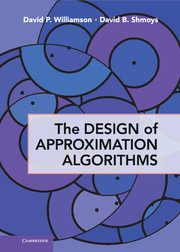Book contents
- Frontmatter
- Contents
- Preface
- I An Introduction to the Techniques
- 1 An Introduction to Approximation Algorithms
- 2 Greedy Algorithms and Local Search
- 3 Rounding Data and Dynamic Programming
- 4 Deterministic Rounding of Linear Programs
- 5 Random Sampling and Randomized Rounding of Linear Programs
- 6 Randomized Rounding of Semidefinite Programs
- 7 The Primal-Dual Method
- 8 Cuts and Metrics
- II Further Uses of the Techniques
- Appendix A Linear Programming
- Appendix B NP-Completeness
- Bibliography
- Author Index
- Subject Index
3 - Rounding Data and Dynamic Programming
from I - An Introduction to the Techniques
Published online by Cambridge University Press: 05 June 2012
- Frontmatter
- Contents
- Preface
- I An Introduction to the Techniques
- 1 An Introduction to Approximation Algorithms
- 2 Greedy Algorithms and Local Search
- 3 Rounding Data and Dynamic Programming
- 4 Deterministic Rounding of Linear Programs
- 5 Random Sampling and Randomized Rounding of Linear Programs
- 6 Randomized Rounding of Semidefinite Programs
- 7 The Primal-Dual Method
- 8 Cuts and Metrics
- II Further Uses of the Techniques
- Appendix A Linear Programming
- Appendix B NP-Completeness
- Bibliography
- Author Index
- Subject Index
Summary
Dynamic programming is a standard technique in algorithm design in which an optimal solution for a problem is built up from optimal solutions for a number of subproblems, normally stored in a table or multidimensional array. Approximation algorithms can be designed using dynamic programming in a variety of ways, many of which involve rounding the input data in some way.
For instance, sometimes weakly NP-hard problems have dynamic programming algorithms that run in time polynomial in the input size if the input is represented in unary rather than in binary (so, for example, the number 7 would be encoded as 1111111). If so, we say that the algorithm is pseudopolynomial. Then by rounding the input values so that the number of distinct values is polynomial in the input size and an error parameter ε > 0, this pseudopolynomial algorithm can be made to run in time polynomial in the size of the original instance. We can often show that the rounding does not sacrifice too much in the quality of the solution produced. We will use this technique in discussing the knapsack problem in Section 3.1.
For other problems, such as scheduling problems, we can often make distinctions between “large” and “small” parts of the input instance; for instance, in scheduling problems, we distinguish between jobs that have large and small processing times. We can then show that by rounding the sizes of the large inputs so that, again, the number of distinct, large input values is polynomial in the input size and an error parameter, we can use dynamic programming to find an optimal solution on just the large inputs.
Information
- Type
- Chapter
- Information
- The Design of Approximation Algorithms , pp. 57 - 72Publisher: Cambridge University PressPrint publication year: 2011
